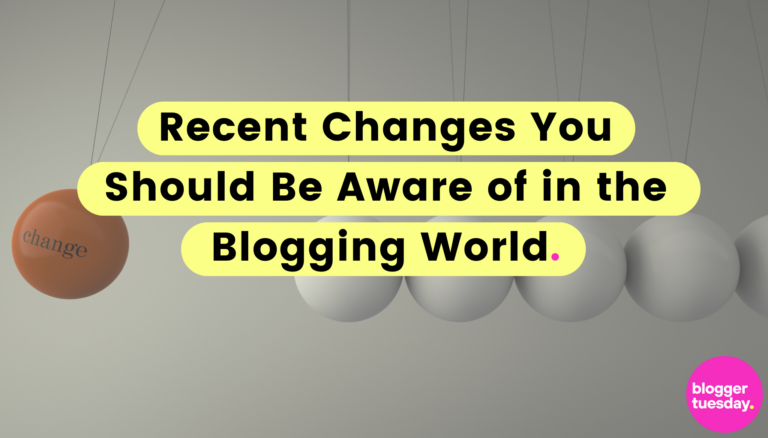Despite being nearly thirty years old, blogging remains incredibly lucrative. Thousands of new blogs come online daily, despite competition from social media platforms.
Research suggests that 409 million people view blogs every month. And that figure is rising because of the sheer number of blogs and niche topics they cover.
So, as you might expect, the blogging world is changing fast. But what are the trends that matter? Let’s find out.
Audio And Visual Content
The most significant trend is the movement towards audio and visual content. Bloggers are still keeping the basic format of a traditional blog but are peppering their articles with explainer videos, graphics, and audio files to improve the richness of the experience.
The extent of this change is significant. Thirty per cent of marketers now primarily create visuals for their blogs, with things like written text taking a backseat.
This change is occurring for several reasons. The most obvious is increasing competition. Even within niches, competition for audience attention is fierce because of the over 600 million blogs on the internet.
The other factor is falling attention spans. Evidence suggests users could concentrate for 75 seconds in 2012 but only 47 seconds a decade later. Consequently, readers need bloggers to break up the text with “rich media.”
Finally, IQ is falling. In general, people are becoming less intelligent and able to comprehend large swathes of text. For many creators, this means video and audio are the only way to communicate effectively.
Increasing Use Of Social Media Platforms
Another recent change in blogging is the pivot to social media platforms. Bloggers now use Facebook, Twitter, and LinkedIn to distribute teasers or snippets of long-form content to entice audiences to their sites.
Again, the reasons for this trend are easy to understand. Bloggers can steadily build audiences on social media platforms over time and use these to drive interest in their content. By contrast, making a blog visible in organic Google searches is challenging.
Bloggers are also taking advantage of the fact that 82 per cent of consumers prefer to search on social media over traditional search engines. Many remain inside the social media environment, making it hard to get found.
Moreover, these platforms help bloggers reach new audiences, build their personal brands, and interact with followers. These functions are considerably more challenging for those who remain cloistered on purpose-built sites.
The Demand For Authenticity
The demand for authenticity is another dramatic change in the blogging space. Audiences are becoming more sophisticated in the choice of content they consume. Readers want authority figures they can trust, not creators with ulterior motives.
You can understand why readers are going in this direction. A broad understanding of “fake news” now means audiences are more critical than previously. People trusted the media they consumed before but now don’t, so bloggers must work harder.
For instance, a Gallup poll found that only 36 per cent of people have a “great deal or fair amount of trust in the mass media” compared to 63 per cent who have “not very much or none at all.” Only 16 per cent of corporate blog readers say they trust them.
In response, bloggers are becoming more transparent, open, and less commercially minded. The goal is to produce the best content instead of generating clicks for affiliate marketing schemes.
To achieve this, many bloggers are:-
- Being upfront and admitting their biases
- Telling their audiences about why they are committing so much time to producing content
- Regularly asking for feedback and suggestions from people in the community to meet their needs
- Sharing their failures and lessons and the areas in which they could still improve
- Giving credit to other bloggers, academics, researchers, or intellectuals when they make contributions
- Using real photos and video footage instead of stock alternatives
- Disclosing any sponsorships or affiliate programs upfront
- Showing their faces
- Engaging with comments and showing readers that they value their input
- Being consistent and sticking to a regular schedule
- Sharing more personal stories to provide readers with additional context
- Being honest and genuine in all interactions, avoiding making any claims unsupported by evidence
- Acknowledging mistakes and referencing them instead of trying to cover them up
Ultimately, bloggers must prove their trustworthiness, now a source of competitive advantage. Creators who break this sacred rule risk being ostracized like The Liver King.
When writing for highly crucial readers, you’ll need to:
- Back up your claims with evidence
- Avoid writing anything you can’t prove
- Avoiding promising anything you can’t deliver
- Including footnotes or citations with links on all your posts
Adopting this approach will help to build trust with your audience. Readers want to see you’ve done the work and know what you are talking about.
Micro-Niche Blogging
Given the vast number of blogs being written daily, many creators are “niching down,” focusing on narrower topics to differentiate themselves from the competition.
The idea is to choose a general topic like “home improvements” and make it into something more specific like “bathroom countertops.” By doing this, bloggers hope to gain more relevant traffic and compete more effectively with their competitors.
Profitable ideas in this category include:
- Skincare product reviews
- Selling on eBay
- Video game tutorials
- Credit card management
- High protein diets
- Cake recipes
- Acne treatments
- Modern kitchens
Micro-niche blogs come with numerous advantages. The main one is the ability to target a specific audience. Bloggers know who their readers are.
These blogs also attract targeted traffic from search engines. People typing in “cake recipes” or “managing credit cards” are highly likely to benefit from sites focusing on these issues, which helps SEO.
Finally, bloggers creating these sites can often sell high-ticket offers to highly interested prospects. Individuals wanting to sell on eBay effectively might be willing to pay hundreds or thousands of dollars for a course that teaches them to do so.
Unfortunately, micro-niche blogs come with some downsides. The main problem is coverage. You can only blog about a limited number of topics, which might limit your output.
The other issue is the lack of expansion. Micro-niche blogs tend to stay small. Bloggers can’t explore topics broadly.
Estimated Reading Time
Bloggers are also including so-called “estimated reading time” on their content to tell readers how long it will take to consume upfront. This tactic helps gain the user’s full attention.
This addition makes sense. Bloggers want to check readers have time to get maximum value from their content. Users are more likely to absorb the salient points if they read the post in one sitting.
It also benefits readers. Many find it annoying having to break off from reading a blog halfway through. Consuming it all in one go is more enjoyable.
Research shows that readers are 40 per cent more engaged when bloggers include an estimated reading time. The longer they remain on the page, the greater the SEO “dwell time” benefit.
The reading speed of most adults is 200 to 250 words per minute. Therefore, calculating how long your audience will take to consume a specific article is straightforward. Just take the article length and divide it by the average reading speed.
Various estimated reading time plugins and add-ons are also available that do this for you automatically, including:
- Reading Time
- Reading Meter
- Reading Time WP
- WP Word Count
- Worth The Read
Choose the one that you feel offers the best functionality. Paid options come with slicker interfaces and more functionality.
TL;DR Summaries
Finally, bloggers are including TL;DR summaries in their posts, reflecting their audience’s falling attention spans and time constraints.
TL;DR is simply short-hand for “too long; didn’t read.” Including it at the top of articles gives users a quick summary of the post’s findings or conclusions.
For many bloggers, including these summaries, is a matter of courtesy. Instead of asking readers to consume content before deciding if it is valuable, TL;DR sections let them do this ahead of time.
TL;DR summaries can also have a beneficial effect on SEO. Google uses these summaries to determine the content of the body text. The search engine may also use them for “rich snippets” or sections of highlighted text that make your site’s hyperlink more visible in search results. As such, bloggers now focus on using TL;DR sections to answer questions right off the bat.
How bloggers are adding TL;DR to their websites is a personal choice. Some use bullet points and numbered lists to get the main ideas across. Others write short, concise sentences conveying the main value.
If you decide to use TL;DR in your blogs, ensure you keep the format consistent. You can also use AI-powered tools, such as TL; DR-ify to help you.
Which Recent Changes Will You Implement?
The only thing left to decide is which of these changes you will implement. Following trends may help you increase your blog’s impact and reach more people.


